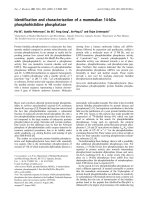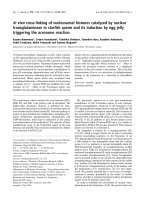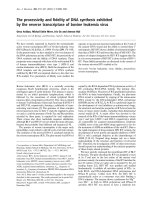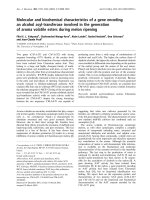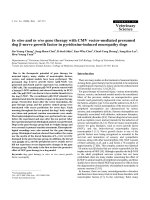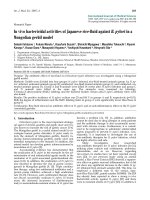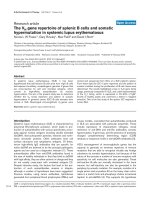Báo cáo Y học: In vitro gene therapy of mucopolysaccharidosis type I by lentiviral vectors pdf
Bạn đang xem bản rút gọn của tài liệu. Xem và tải ngay bản đầy đủ của tài liệu tại đây (199.99 KB, 8 trang )
In vitro
gene therapy of mucopolysaccharidosis type I by lentiviral
vectors
Paola Di Natale
1
, Carmela Di Domenico
1
, Guglielmo R. D. Villani
1
, Angelo Lombardo
2
, Antonia Follenzi
2
and Luigi Naldini
2
1
Department of Biochemistry and Medical Biotechnologies, University of Naples Federico II; Italy
2
Laboratory for Gene Transfer
and Therapy, Institute for Cancer Research and Treatment, University of Turin, Italy
Mucopolysaccharidosis type I (MPS I) results from a defi-
ciency in the enzyme a-
L
-iduronidase (IDUA), and is char-
acterized by skeletal abnormalities, hepatosplenomegaly and
neurological dysfunction. In this study, we used a late gen-
eration lentiviral vector to evaluate the utility of this vector
system for the transfer and expression of the human IDUA
cDNA in MPS I fibroblasts. We observed that the level of
enzyme expression in transduced cells was 1.5-fold the level
found in normal cells; the expression persisted for at least
two months. In addition, transduced MPS I fibroblasts were
capable of clearing intracellular radiolabeled glycosami-
noglycan (GAG). Pulse-chase experiments on transduced
fibroblasts showed that the recombinant enzyme was
synthesized as a 76-kDa precursor form and processed to a
66-kDa mature form; it was released from transduced cells
and was endocytosed into a second population of untreated
MPS I fibroblasts via a mannose 6-phosphate receptor.
These results suggest that the lentiviral vector may be used
for the delivery and expression of the IDUA gene to cells
in vivo for treatment of MPS I.
Keywords: MPS I; Hurler syndrome; a-
L
-iduronidase; gene
therapy.
Mucopolysaccharidosis type I (MPS I) is a lysosomal
disease due to mutations in the gene encoding
a-
L
-iduronidase (IDUA, EC 3.2.1.76). The gene defect
causes a specific deficiency that results in the intracellular
accumulation and storage of the unprocessed glycosami-
noglycans (GAG), dermatan sulfate and heparan sulfate.
Patients with MPS I show variable clinical phenotypes, the
most severe of which is Hurler’s syndrome, with progres-
sive neurological dysfunction and skeletal and soft tissue
anomalies that can lead to death within the first decade. In
less severe forms of this disease, such as the intermediate
Hurler–Scheie syndrome or the mild Scheie syndrome, no
mental retardation and only mild symptoms occur [1]. The
difference in severity is due primarily to the effect of
various mutations in the human IDUA gene, located on
the short arm of chromosome 4 [2–4]. Homozygosity as
well as compound heterozygosity for some mutations (e.g.
W402X and Q70X) results in the most severe phenotype,
Hurler syndrome, while some alterations permit residual
enzyme activity that results in the mild phenotype (for
reviews see [1,5]). Recently, a large mutational analysis was
described including in vitro expression of missense muta-
tions [6]; our group contributed to the characterization of
defects in Italian population [7].
Therapies for MPS I include allogeneic bone marrow
transplantation [8–10] and enzyme replacement therapy
(ERT) [11]; in vitro transduction of IDUA cDNA in
cultured cells gave promising results [12–17]. Correction of a
metabolic defect is based on early biochemical findings:
lysosomal enzymes are post-translationally processed to
contain mannose 6-phosphate residues that bind to man-
nose 6-phosphate receptors, which target enzymes to
lysosomes. Receptors are also present on the cell membrane
and are able to bind circulating extracellular enzymes and
deliver them to the lysosomes [18]. Results obtained with
ERT were encouraging although inconvenient, because the
therapy has to be performed weekly. Thus, the search for
alternative therapies is motivated, first to be tested in vitro or
on animal models. A naturally occurring canine model has
been useful in testing direct enzyme replacement [19] and the
murine knock-out model [20] represents a promising tool
for the development of new therapies.
The availability of the MPS I murine model and the
recent results obtained with the use of lentiviral vectors on
two lysosomal diseases [21,22] have allowed us to initiate a
program aimed at developing gene therapy for MPS type I
syndrome. As a first step in this project, we have constructed
a lentiviral vector carrying the human IDUA cDNA and
have tested it in vitro on fibroblasts from affected patients.
Here, we describe the capacity of this vector to mediate high
levels of IDUA expression in transduced cells. In addition,
we demonstrate that the IDUA enzyme released from
transduced cells is endocytosed and correctly processed in
nontransduced cells, indicating the potential for metabolic
cross-correction and for the therapeutic application of this
system.
Correspondence to P. Di Natale, Department of Biochemistry and
Medical Biotechnologies, University of Naples Federico II, Via S.
Pansini, 5, 80131 Naples, Italy.
Fax: + 39 081 7463150, E-mail:
Abbreviations: IDUA, a-
L
-iduronidase; GAG, glycosaminoglycan;
MPS I, mucopolysaccharidosis type I; ERT, enzyme replacement
therapy; DMEM, Dulbecco’s modified Eagle’s medium; PPT,
polypurine tract.
(Received 2 January 2002, revised 19 March 2002,
accepted 22 April 2002)
Eur. J. Biochem. 269, 2764–2771 (2002) Ó FEBS 2002 doi:10.1046/j.1432-1033.2002.02951.x
MATERIALS AND METHODS
Cells
Normal human diploid fibroblasts were obtained from skin
biopsies, while Hurler fibroblasts were cells 72/92 obtained
from the Gaslini Institute, Genoa, Italy. The cells were
grown in Dulbecco’s modified Eagle’s medium (DMEM,
Life Technologies) containing 10% fetal bovine serum
(Sigma), 100 UÆmL
)1
penicillin, 100 mgÆmL
)1
streptomycin
and 2 m
ML
-glutamine. Cells were cultured at 37 °Cina5%
CO
2
humidified incubator.
Lentiviral vector containing IDUA cDNA
The human IDUA cDNA was excised from expression
plasmid pBSIIKS-hIdu obtained from E. F. Neufeld,
UCLA School of Medicine, Los Angeles, CA, USA.
The 2.2-Kb human IDUA cDNA was excised from this
plasmid by digestion with XbaI followed by filling-in with
klenow polymerase and a second digestion with MluI. The
purified band was then subcloned into plasmid
pRRLsinPPT.CMV.WPRE after double digestion of this
vector with MscIandMluI to obtain the self inactivating
(sin) gene transfer construct PRRLsinPPT.CMV.
IDUA.WPRE. The packaging of the vector was obtained
as described previously [23,24] by cotransfection of 293T
cells with four different constructs: the pMDLg/pRRE, a
multiple attenuated packaging construct containing
the RRE sequence coding for HIV-1 gag and pol genes,
the pRSV-Rev construct expressing Rev protein, the
pMD2.G, which produces the VSV.G protein and
the plasmid pRRLsinPPT.CMV.IDUA.WPRE (or
pRRLsinPPT.CMV.GFP.WPRE as control construct).
The viral particles were obtained by concentration of
293T-conditioned media through ultracentrifugation at
50 000 g for 140 min. Quantification of viral content was
performed by immunocapture of HIV-1 p24 antigen by
using HIV-1 p24 Core profile ELISA (NEN Life Science
Products).
Lentiviral infection of MPS I fibroblasts
MPS I fibroblasts were grown at 80% confluency, and
transduced with increasing doses of IDUA vector (1, 10
and 50 ng of p24 viral protein) in the absence or in the
presence of polybrene (5 lgÆmL
)1
). After a 24-h incubation
at 37 °C, the medium was changed, and the cells were
incubated for 2 additional days before harvesting. For
expression persistence over the course of time, MPS I
fibroblasts were transduced with 50 ng p24, and replicate
plates were maintained and expanded until cells showed
aging (i.e. 2 months). After harvesting, the IDUA enzyme
activity was measured in the cell lysates. To evaluate the
transduction efficiency, control infections were performed
using 20 ng of green fluorescent protein (GFP) vector;
after incubation fibroblasts grown on coverslips were fixed
with 3.7% formaldehyde in NaCl/P
i
, washed once with
0.1
M
glycine in NaCl/P
i
, twice with NaCl/P
i
and once with
H
2
O. The fluorescence was visualized under an Axioplan
fluorescence microscope (Zeiss).
Detection of the integrated lentiviral-IDUA construct
by Alu-PCR
Cell extracts from transduced and untransduced MPS I
fibroblasts were prepared as described previously [25]. For
Alu-PCR reactions, two different primers pairs were used:
one at the 5¢ end and the other at the 3¢ end of the vector
genome. Primers for the 5¢ end were Alu3¢ sense [25] and
5NC2 antisense: 5¢-GAGTCCTGCGTCGAGAGAG-3¢
[26]; the other pair at the 3¢ end was Alu278 antisense [25]
and Wpre sense: 5¢-CTTTCCATGGCTGCTCCC-3¢ [26].
The PCR procedure required a 10 min initial denaturation
step (95 °C) followed by 30 cycles at 94 °Cfor1min,57°C
(for the 5¢Alu-PCR) or 49 °C(forthe3¢Alu-PCR) for
1min,and72°C for 1 min. After this first amplification, a
nested PCR was performed using 10 lL of the first PCR
product with two different internal primers in the vector
genome. For the 5¢ nested PCR the primers were:
LTR9 (sense: 5¢-GCCTCAATAAAGCTTGCCTTG-3¢)
and U5PBS (antisense: 5¢-GGCGCCACTGCTAGAGAT
TTT-3¢), amplifying a fragment of 121 bp [26]. For the
3¢ nested PCR the primers used were: Dnef (sense:
5¢-CGAGCTCGGTACCTTTAAGACC-3¢) and LTR8
(antisense: 5¢-TCCCAGGCTCAGATCTGGTCTAAC-3¢)
amplifying a fragment of 166 bp [26]. Nested PCR condi-
tions were similar to the first amplification, differing in
dNTPs and primer concentrations (0.2 m
M
and 0.5 l
M
,
respectively) and in the annealing temperature, which was
55 °Cforthe5¢ nested PCR and 58 °Cforthe3¢ nested
PCR. As a control, a nested PCR was performed using 1 lL
of nonamplified lysate from transduced fibroblasts.
a-
L
-Iduronidase enzyme assay
a-
L
-Iduronidase activity in untreated and transduced fibro-
blasts was determined as previously described [27] using a
fluorogenic substrate. Cells were harvested with trypsin,
washed in NaCl/P
i
, resuspended in 0.9% NaCl, and lysed
by six cycles of freezing-thawing. The protein concentration
was quantified using the Lowry assay [28]. The reaction was
performed in 0.1
M
formate pH 3.2, with 2 m
M
4-methyl-
umbelliferyl-a-
L
-iduronide (Calbiochem), at 37 °Cfor1h.
The reaction was stopped by adding 0.5
M
Na
2
CO
3
/
NaHCO
3
buffer, pH 10.7. The liberated 4
M
U was detected
fluorimetrically with 365-nm excitation and 448-nm emis-
sion filters.
Correction of metabolic defect in transduced MPS I
fibroblasts
MPS I fibroblasts were plated in replicate 6-cm plates and
transduced with 50 ng p24, as described above. Seven and
14 days after viral infection, transduced and untransduced
cells were treated with SO
4
-free medium (ICN Biomedicals)
containing 10% fetal bovine serum dialyzed for 24 h. Cells
were then incubated in the same medium in the presence of
40 · 10
6
counts per min (c.p.m.) of H
35
2
SO
4
(Amersham
Pharmacia Biotech) per plate. After 48 h at 37 °C, cells were
harvested and washed three times in NaCl/P
i
; the pellet was
resuspended in 10 m
M
sodium phosphate pH 5.8 contain-
ing 0.5% NP-40, and lysed by three cycles of freezing and
Ó FEBS 2002 Lentiviral vector-mediated IDUA gene transfer (Eur. J. Biochem. 269) 2765
thawing. Lysates were cleared by centrifugation at
6200 g for 5 min in an Eppendorf microfuge and the
supernatants were assessed for radioactivity and total cell
proteins.
Metabolic labeling of recombinant IDUA in transduced
MPS I fibroblasts
Fibroblasts transduced with 50 ng p24 were metabolically
labeled 3 days after infection. In detail, the cells were placed
in 6-cm plates and starved for 2 h in 1.5 mL methionine-
cysteine-free medium (DMEM, ICN Biomedicals) supple-
mented with 2% fetal bovine serum. This medium was then
changed for one of the same composition containing
300 lCi of
35
S-Express Protein Labeling Mix (NEN Life
Science Products). After a 2-h labeling period (pulse), the
cells were chased for 24 h in DMEM medium supplemented
with 0.3 gÆL
)1
nonradioactive methionine and cysteine. The
medium was then collected and concentrated to 0.5 mL
using a Millipore Centricon Centrifugal Filter Device, with
YM-30 membrane, by spinning 2 h at 2200 g in a Beckman
centrifuge CS-6R. Cells were washed with NaCl/P
i
and lysed on ice for 30 min in 1 mL lysis buffer (10 m
M
Tris/HCl buffer pH 7.4, 150 m
M
NaCl, 1 m
M
EDTA
pH 8.0, 0.1% Triton X-100) containing 0.2 m
M
phenyl-
methanesulfonyl fluoride, 1 l
M
pepstatin A and 1 l
M
leupeptin. Labeled a-
L
-iduronidase was immunopreci-
pitated from cells and medium using 1 lL of specific
antiserum. The immunocomplexes were precipitated with
30 lL protein A-agarose (Santa Cruz Biotechnology),
washed four times with lysis buffer and analyzed by
SDS/PAGE followed by autoradiography.
Correction of MPS I fibroblasts by enzyme released
from transduced cells
MPS I fibroblasts were grown in 6-cm plates and trans-
duced with 50 ng p24 of IDUA vector. Three days after
viral infection, transduced cells were placed in the upper
chambers of a trans-well system (Costar, Cambridge, MA,
USA; 0.45 lm) and co-cultivated in the presence of deficient
cells grown in the lower chambers. After a 72-h incubation,
cells were harvested and the enzyme activity was measured
in the cell lysates. The experiments were performed in the
absence or in the presence of mannose 6-phosphate at a final
concentration of 5 m
M
. In a similar set of experiments,
transduced fibroblasts in the upper chambers were starved
2 h with methionine-cysteine-free medium and labeled with
35
S-Express Protein Labeling Mix for 72 h. The recipient
untransduced cells in the lower chambers and the condi-
tioned medium from transduced fibroblasts were then
harvested, immunoprecipitated and processed as described
above.
RESULTS
Lentiviral vector expressing human IDUA cDNA
A third-generation VSV-pseudotyped lentiviral vector con-
taining IDUA cDNA was constructed and prepared using a
conditional packaging system [23]. The proviral form of the
vector is shown in Fig. 1. The packaging system contains
the self-inactivating transducing constructs (sin) obtained
after a 400-bp deletion including the enhancer and promoter
from U3. The system conserves only three of the nine HIV-1
genes and relies on four separate transcriptional units for the
production of transducing particles. This system offers
significant advantages for its biosafety and allows the
production of high-titer HIV-derived vector stocks. In
addition, this late-generation gene transfer construct con-
tains the polypurine tract (PPT), the structural element from
pol of HIV-1 virus encompassing the central PPT and
termination sequences. These were previously reported to
enhance gene transfer into primary cells including peripheral
blood lymphocytes, macrophages, fibroblasts and endo-
thelial cells [24].
Evaluation of transgene expression and transduction
efficiency
To analyse lentiviral-vector-mediated IDUA transduction
and expression, a set of experiments were performed using
MPS I fibroblasts. Cells were transduced with three differ-
ent doses (1, 10, and 50 ng) of p24 viral protein, in the
absence or in the presence of 5 lgÆmL
)1
of polybrene
(Table 1), as described in Materials and methods. Trans-
duced fibroblasts, in triplicate plates, showed an increased
enzymatic activity, both in the absence of polybrene (means
of 6, 22 and 117 nmolÆh
)1
Æmg
)1
) or in the presence of
polybrene (means of 20, 32, and 155 nmolÆh
)1
Æmg
)1
). The
IDUA activity obtained after infection was 1.5 the level
observed in normal control cells (98 nmolÆh
)1
Æmg
)1
).
Transduction efficiency was evaluated by detection of
fluorescence after infection of MPS I cells with 20 ng
of lentiviral-GFP; efficiency was calculated as number of
Fig. 1. Diagram of lentiviral vector carrying the human IDUA cDNA.
Gene transfer vector includes the following elements from the 5¢ to the 3¢
end: viral cis-acting sequences (5¢ LTR region; splice donor site, 5¢ss;
encapsidation signal, w; a portion of the HIV-1 gag gene, mut GAG;
Rev response element, RRE; splice acceptor sites, 3¢ss; polypurinic and
termination HIV-1 pol sequences enhancing nuclear translocation,
PPT); the expression cassette for IDUA cDNA with the promoter of the
human cytomegalovirus CMV and the post-transcriptional regulatory
element from woodchuck hepatitis virus WPRE; 3¢ LTR sequences.
Table 1. a-
L
-Iduronidase activity in MPS I fibroblasts after transduc-
tion with lentiviral vector. Increasing amounts of IDUA vector were
added to MPS I fibroblasts as indicated. Cells, in triplicate plates, were
incubated for 2.5 days before harvesting for IDUA activity. Data
show mean ± SD. Untreated MPS I fibroblasts have an enzyme
activity of 0.25 ± 0.03 nmolÆh
)1
Æmg
)1
;normalfibroblastshavean
enzyme activity of 98 ± 13 nmolÆh
)1
Æmg
)1
.
IDUA Vector
(ng p24)
a-
L
-Iduronidase activity (nmolÆh
)1
Æmg
)1
)
– Polybrene + Polybrene
1 6 ± 1 20 ± 4.5
10 22 ± 5.5 32 ± 4.1
50 117 ± 19.31 155 ± 18.1
2766 P. Di Natale et al. (Eur. J. Biochem. 269) Ó FEBS 2002
fluorescent cells over the total number of cells and was
estimated to be 70% (data not shown).
Long-term IDUA transgene expression in transduced
MPS I fibroblasts
To investigate the IDUA expression over the course of many
weeks, MPS I fibroblasts were transduced with 50 ng of p24
viral protein, in the presence of polybrene. Transduced cells
were subcultured every week and maintained for 2 months,
during which time cell samples were collected every 5–7 days.
In transduced cells, the specific IDUA activity showed a
linear increase, with a highest point found 3 weeks after
transduction (520 nmolÆh
)1
Æmg
)1
), and persisted at high
levels (about 400 nmolÆh
)1
Æmg
)1
) for almost 8 weeks, when
the experiment was concluded due to cell aging (Fig. 2A).
The increase of IDUA activity to four to five times normal
levels from the initial levels after culture in the absence of
selection was probably due to some selective advantage
of metabolically corrected cells. To assess vector integration
in transduced MPS I fibroblasts, Alu-PCR reactions were
performed, as described in Materials and methods, on
cellular extracts prepared from untreated and transduced
fibroblasts on day 27 after infection. Reactions included a
first amplification using two different primer pairs specific
for Alu ubiquitous repeats and for 3¢ or 5¢ end of the
lentiviral vector genome, respectively, followed by a nested
PCR to amplify sequences from the vector DNA. As
expected, both for 3¢ and 5¢-Alu-PCR no bands were visible
after the first amplification (Figs 2B, lanes 1–3); visible bands
were obtained only after nested PCR (Figs 2B, lanes 4–7).
Reactions corresponding to the transduced MPS I fibro-
blasts amplified a single band of 166 bp from the 3¢ end and
a 121-bp fragment from the 5¢ end (Figs 2B, lane 5), while no
fragments were visible for the untreated cells (Figs 2B, lane
6) or for the control using as template cell lysate not subjected
to the first amplification (Figs 2B, lane 7).
Correction of metabolic defect in transduced MPS I
fibroblasts
To verify if the GAG accumulation could be corrected by
treatment with lentiviral vector, cells were infected and then
cultured in the presence of H
35
2
SO
4
. The GAG level
measured in transduced cells 1 or 2 weeks after infection
resulted decreased, approaching the level found in normal
cells (Table 2). The results showed the correction of the
defective glycosaminoglycan catabolism after treatment
with vector.
Metabolic labeling of recombinant IDUA enzyme
in transduced MPS I fibroblasts
The maturation of the recombinant IDUA enzyme was
studied through metabolic labeling experiments in trans-
duced fibroblasts as described in Materials and methods.
Three days after infection, transduced cells were labeled for
a 2-h pulse period and harvested after a 24-h chase period.
In addition, the medium surrounding cells was harvested
after the same 24 h chase period to see the precursor form of
the enzyme. Radioactivity incorporated into IDUA was
shown after immunoprecipitation and separation by SDS/
PAGE. In the medium a precursor form of 76 kDa was
identified; in the cells a mature polypeptide of 66 kDa was
detected, as shown after the 24 h chase (Fig. 3). These
results on the maturation of the recombinant protein are in
agreement with those previously obtained on IDUA
processing in cultured cells [29,30].
Correction of MPS I fibroblasts by enzyme released
from transduced cells
To evaluate the capacity of transduced cells to release the
IDUA enzyme to the extracellular environment, from which
it can be taken up and contribute to lysosomal metabolism
in nontransduced cells, coculture experiments were per-
formed as described in Materials and methods. As shown in
Fig. 4, the deficient cells cultured in the presence of
transduced MPS I fibroblasts exhibited an enzyme activity
Fig. 2. Persistence of vector-mediated transduction. (A) Enzyme activity
in MPS I fibroblasts transduced with 50 ng p24 viral protein. Replicate
wells of MPS I cells were exposed to the indicated viral dose as des-
cribed in Materials and methods and cells were collected at different
time points from infection; lysates were assayed for protein content and
enzyme activity (mean ± SD, n ¼ 3). (B) Alu-PCR analysis to test
the lentiviral-vector integration. Untreated and transduced cell extracts
were assayed by PCR as described in Materials and methods. Ampli-
fication was performed with two different primer pairs, one at the
3¢ end and the other at the 5¢ end of the vector genome. After the first
amplification (lanes 1–3) no band was visible. The nested reaction
(lanes 4–6) amplified a fragment of 166 and 121 bp at-3¢ and 5¢ end of
the vector DNA, respectively. M: 100 bp marker; lanes 1 and 4: blank
reaction; lanes 2 and 5: transduced fibroblasts; lanes 3 and 6: untreated
cells; lane 7: control reaction amplified only with nested PCR.
Ó FEBS 2002 Lentiviral vector-mediated IDUA gene transfer (Eur. J. Biochem. 269) 2767
of 116 nmolÆh
)1
Æmg
)1
, vs. an activity of 0.3 nmolÆh
)1
Æmg
)1
found in untransduced cells. Taking into account the total
enzyme units (70) measured in the extracellular medium and
the total enzyme units (10) recovered in the recipient cells
after co-culture, a value of 14% endocytosis was calculated.
In the presence of 5 m
M
mannose 6-phosphate, the enzyme
activity in the recipient cells reached the basal levels of
untreated MPS I fibroblasts, showing a strong inhibition of
the uptake by mannose 6-phosphate (Fig. 4).
In another set of experiments, co-culture was performed
in the presence of a labeling protein mixture to see whether
the recaptured enzyme was correctly processed. The results
are shown in Fig. 5. The enzyme released in the culture
medium, the precursor form of 76 kDa, was correctly
endocytosed by recipient cells to become the mature 66 kDa
protein. In the presence of mannose 6-phosphate, no mature
form was immunoprecipitated from recipient cells, thus
demonstrating that transduced MPS I fibroblasts can
secrete a functional IDUA enzyme that can enter enzyme-
deficient cells by the well characterized mannose 6-phos-
phate mechanism [18].
DISCUSSION
MPS I has always been considered a candidate for gene
therapy because high levels of IDUA expression may not be
necessary to correct the lysosomal metabolism. It has been
reported, in fact, that the presence of less than 1% of normal
Table 2. Correction of
35
S-glycosaminoglycan accumulation in transduced MPS I fibroblasts. MPS I fibroblasts in 6-cm dishes were transduced with
50 ng p24 viral protein; six (experiment 1) or 13 days (experiment 2) after transduction, treated and untreated cells were incubated in SO
4
-free
medium overnight. Fibroblasts were then added with fresh medium in the presence of 40 · 10
6
c.p.m. of H
35
2
SO
4
per dish, and incubated for 48 h.
Cells were harvested and assayed for
35
SO
4
-glycosaminoglycan accumulation and protein content (mean ± SD, n ¼ 3)asdescribedinMaterials
and methods. U, untreated; T, transduced; N, normal fibroblasts.
35
S-Glycosaminoglycans (c.p.m. per mg)
UT N
Experiment 1 127 000 ± 17 473 10 000 ± 4509 8340 ± 3120
Experiment 2 40 000 ± 6658 7322 ± 1761 6820 ± 2318
Fig. 3. Synthesis of recombinant a-
L
-iduronidase in transduced MPS I
fibroblasts. Untreated and transduced fibroblasts were grown to sub-
confluence and metabolically labeled with 300 lCi of
35
S-Express
Protein Labeling Mix for 2 h. The labeling medium was then removed
and the cells were chased in growth medium for 24 h. After this time
labeled cells and corresponding medium were harvested, immunopre-
cipitated and analysed via SDS/PAGE and autoradiography. The
molecular masses of the protein standards are indicated on the left. U,
untreated fibroblasts; T, transduced fibroblasts; M, medium; C, cell
lysate. The arrows on the right indicate the 76 kDa precurson form
and the 66 kDa mature form of the enzyme.
Fig. 4. Correction of MPS I fibroblasts by enzyme released from
transduced deficient cells. Transduced fibroblasts, which can secrete the
IDUA enzyme, were cultured in the presence of recipient deficient cells
in separate chambers of a trans-well system as described in Materials
and methods. After 72 h of coculture, recipient cells were harvested to
measure enzyme activity.
2768 P. Di Natale et al. (Eur. J. Biochem. 269) Ó FEBS 2002
IDUA activity in patients will moderate the severe clinical
symptoms related to Hurler syndrome [1].
A third generation lentiviral vector was constructed to
transduce human a-
L
-iduronidase cDNA into MPS I
fibroblasts. The vector contained only a fractional set of
HIV genes: gag, pol and rev, which are nonfunctional
outside the producer cells [23,24]. High transduction
efficiency (70%) was found and the lentiviral vector
proved to be integrated in transduced cell, as seen by
Alu-PCR analysis. Transduced MPS I fibroblasts expres-
sed high levels of IDUA activity (1.5-fold the normal
control cells) and reduced levels of
35
S-labeled glycos-
aminoglycans, approaching those observed in normal
control cells. IDUA activity persisted in transduced cells
for at least 2 months; after that time it was not
monitored due to cell aging. In addition, transduced
fibroblasts showed correct processing of the IDUA
protein, from the precursor form of 76 kDa to the
mature form of 66 kDa. Even more importantly, the
excess enzyme released into the surrounding medium of
transduced cells was endocytosed by the deficient cells
through the well-characterized mannose 6-phosphate-
mediated receptor mechanism [17] and was trimmed
from the 76 kDa precursor form to the characteristic
intracellular mature form of 66 kDa. These results are
particularly important in the gene transfer approaches to
treatment of mucopolysaccharidosis type I because they
imply that the introduction of a therapeutic IDUA gene
by lentiviral vector into a small portion of target cells
may result in the release of the expressed enzyme from
these transduced cells with a subsequent uptake by
unmodified cells and tissues and correction of the
lysosomal metabolism.
In vitro correction of mucopolysaccharidosis type I cells
has been obtained in the last few years using retroviral
vectors [12–16] or an adeno-associated vector [17] trans-
ducing the IDUA cDNA. Anson et al. [12] first reported
an expression of high levels of human iduronidase after
retroviral transduction of MPS I fibroblasts. The trans-
duction of hematopoietic stem cells was studied by
Fairbain et al. [13], who demonstrated retrovirus-mediated
IDUA gene transfer into MPS I CD34
+
cells, with high
levels of IDUA activity detectable in a significant
percentage of these cells. Huang et al.[14]characterized
a series of retroviral IDUA vectors that also exhibited
efficient gene transfer into MPS I bone marrow cells;
Stewart et al. [15] showed that primary neuronal and
astrocyte cultures were capable of taking up the enzyme
from the supernatant of fibroblasts transduced with an
IDUA retroviral vector; Pan et al. [16] compared the
efficacy of different IDUA retroviral constructs in expres-
sing IDUA cDNA in MPS I CD34
+
cells and in MPS I
fibroblasts; Hartung et al.[17]usedanIDUAadeno-
associated vector to transduce 293 cells and MPS I
fibroblasts, obtaining high levels of IDUA activity and
intercellular metabolic cross-correction.
Here, we have extended these transfer studies to verify
the lentivirus as an effective system for IDUA gene
delivery and expression at levels sufficient to provide
cross-correction of co-incubated, untransduced cells. Len-
tiviral vectors have been shown to effectively transduce
genes into a range of both dividing and nondividing cell
types, including neurons, retinal cells, muscle cells and
hematopoietic pluripotent cells [31–35]. More recently, a
late generation lentiviral vector was used to deliver
arylsulfatase A cDNA into the brain of metachromatic
leukodystrophy mice [21] and b-glucuronidase cDNA into
the brain of mucopolysaccharidosis type VII mice [22],
showing that the in vivo transfer of genes by lentiviral
vectors reverts the disease phenotype in all areas investi-
gated.
In conclusion, the lentiviral vector reported here pro-
vides high levels of IDUA expression in recipient cells
in vitro and may also provide sufficient expression in
deficient cells and tissues in vivo to similarly reduce or
prevent storage accumulation in IDUA-deficient animals
and then in MPS I patients. The existing knock-out
murine model [20] therefore provides an excellent test
system. Future studies will test the ability of this vector to
mediate gene transfer and expression in appropriate targets
in vivo (muscle, brain, hematopoietic cells) and correct
GAG storage in murine MPS I cells as a model for gene
therapy of human MPS I.
ACKNOWLEDGEMENTS
We thank Prof Elizabeth F. Neufeld, UCLA School of Medicine, for
providing us with the pBSIIKS-hIdu plasmid and anti-IDUA anti-
bodies.
We thank the ÔLaboratorio di Diagnosi Pre-Postnatale Malattie
Metaboliche ÔIstituto G. Gaslini for providing us with specimens from
the collection ÔCell lines and DNA bank from patients affected by
Genetic disease, supported by Telethon grants (project C.52) and Mrs
R. Baldoni for typewriting.
This work was supported by a grant from MURST to Prof P. Di
Natale and Prof. Franco Zacchello (University of Padua, Italy).
Fig. 5. Uptake of secreted recombinant IDUA into MPS I fibroblasts.
Transduced MPS I fibroblasts were cocultured in the presence of
untreated deficient cells in a trans- well system and labeled for 72 h,
with labeling protein mixture in the absence or in the presence of 5 m
M
mannose 6-phosphate, as described in Materials and methods. The
conditioned medium from the upper chambers was then collected and
concentrated; the recipient cells in the lower chambers were harvested.
IDUA molecules were immunoprecipitated and subjected to SDS/
PAGE and autoradiography. The molecular masses of protein
standards are indicated on the left. M, medium; C, cell lysate. The
arrows on the right indicate the 76 kDa precursor form and the
66 kDa mature form of the enzyme.
Ó FEBS 2002 Lentiviral vector-mediated IDUA gene transfer (Eur. J. Biochem. 269) 2769
REFERENCES
1. Neufeld, E.F. & Muenzer, J. (2001) The mucopolysaccharidoses.
In Scriver, C.R., Beaudet, A.L., Sly, W.S. & Valle, D., eds. The
Metabolic and Molecular Bases of Inherited DiseaseÕ, 8th edn. pp.
3421–3452. McGraw-Hill, New York:
2. Scott,H.S.,Ashton,L.J.,Eyre,H.J.,Baker,E.,Brooks,D.A.,
Callen, D.F., Sutherland, G.R., Morris, C.P. & Hopwood, J.J.
(1990) Chromosomal localization of the human alpha-
L
-iduroni-
dase gene (IDUA) to 4p16.3. Am.J.Hum.Genet.47, 802–807.
3. Scott, H.S., Anson, D.S., Orsborn, A.M., Nelson, P.V., Clements,
P.R., Morris, C.P. & Hopwood, J.J. (1991) Human a-
L
-iduroni-
dase: cDNA isolation and expression. Proc. Natl Acad. Sci. USA
88, 9695–9699.
4. Scott, H.S., Guo, X.H., Hopwood, J.J. & Morris, C.P. (1992)
Structure and sequence of the human a-
L
-iduronidase gene.
Genomics 13, 1311–1313.
5. Scott, H.S., Bunge, S., Gal, A., Clarke, L.A., Morris, C.P. &
Hopwood, J.J. (1995) Molecular genetics of mucopolysacchari-
dosis type I: diagnostic, clinical, and biological implication. Hum.
Mutat. 6, 288–302.
6. Beesley, C.E., Meaney, C.A., Greenland, G., Adams, V., Vellodi,
A., Young, E.P. & Winchester, B.G. (2001) Mutational analysis of
85 mucopolysaccharidosis type I families: frequency of known
mutations, identification of 17 novel mutations and in vitro
expression of missense mutations. Hum. Genet. 109, 503–511.
7. Gatti, R., Di Natale, P., Villani, G.R.D., Filocamo, M., Muller,
V., Guo, X.H., Nelson, P.V., Scott, H.S. & Hopwood, J.J. (1997)
Mutations among Italian mucopolysaccharidosis type I patients.
J. Inherit. Metab. Dis. 20, 803–806.
8. Withley, C.B., Belani, K.G., Chang, P.N., Summers, C.G., Blazar,
B.R., Tsai, M.Y., Latchaw, R.E., Ramsay, N.K. & Kersey, J.H.
(1993) Long-term outcome of Hurler syndrome following bone
marrow transplantation. Am.J.Med.Genet.46, 209–218.
9. Vellodi, A., Young, E.P., Cooper, A., Wraith, J.E., Winchester,
B., Meaney, C., Ramaswami, U. & Will, A. (1997) Bone marrow
transplantation for mucopolysaccharidosis type I: experience of
two British centers. Arch.Dis.Child.76, 92–99.
10. Peters, C., Shapiro, E.G., Anderson, J., Henslee-Downey, P.J.,
Klemperer, M.R., Cowan, M.J., Saunders, E.F., DeAlarcon, P.A.,
Twist, C., Nachman, J.B., Hale, G.A., Harris, R.E., Rozans,
M.K., Kurtzberg, J., Grayson, G.H., Williamson, T.E., Lenarsky,
C., Wagner, J.E. & Krivit, W. (1998) Hurler syndrome. Outcome
of HLA-genotypically identical sibling and HLA-haploidentical
related donor bone marrow transplantation in fifty-four children.
The storage Disease Collaborative Study Group. Blood 91, 2601–
2608.
11. Kakkis, E.D., Muenzer, J., Tiller, G.E., Waber, L., Belmont, J.,
Passage,M.,Izykowski,B.,Phillips,J.,Doroshow,R.,Walot,I.,
Hoft, R. & Neufeld, E.F. (2001) Enzyme-replacement therapy in
mucopolysaccharidosis I. N. Engl. J. Med. 344, 182–188.
12. Anson, D.S., Bielicki, J. & Hopwood, J.J. (1992) Correction of
mucopolysaccharidosis type I fibroblasts by retroviral-mediated
transfer of the human alpha-
L
-iduronidase gene. Hum. Gene Ther.
3, 371–379.
13. Fairbairn, L.J., Lashford, L.S., Spooncer, E., McDermott, R.H.,
Lebens, G., Arrand, J.E., Arrand, J.R., Bellantuono, I., Holt, R.,
Hatton, C.E., Cooper, A., Besley, G.T., Wraith, J.E., Anson, D.S.,
Hopwood, J.J. & Dexter, T.M. (1996) Long-term in vitro correc-
tion of a-
L
-iduronidase deficiency (Hurler syndrome) in human
bone marrow. Proc. Natl Acad. Sci. USA 93, 2025–2030.
14. Huang, M.M., Wong, A., Yu, X. & Kohn, D.B. (1997) Retrovi-
rus-mediated transfer of the human a-
L
-iduronidase cDNA into
human hematopoietic progenitor cells leads to correction in trans
of Hurler fibroblasts. Gene Ther. 4, 1150–1159.
15. Stewart, K., Brown, O.A., Morelli, A.E., Fairbairn, L.J., Lash-
ford, L.S., Cooper, A., Hatton, C.E., Dexter, T.M., Castro, M.G.
& Lowenstein, P.R. (1997) Uptake of a-
L
-iduronidase produced
by retrovirally transduced fibroblasts into neuronal and glial cells
in vitro. Gene Ther. 4, 63–75.
16. Pan, D., Aronovich, E.L., McIvor, R.S. & Whitley, C.B. (2000)
Retroviral vector design studies toward hematopoietic stem cell
gene therapy for mucopolysaccharidosis type I. Gene Ther. 7,
1875–1883.
17. Hartung, S.D., Reddy, R.G., Whitley, C.B. & McIvor, R.S. (1999)
Enzymatic correction and cross-correction of mucopolysaccari-
dosis type I fibroblasts by adeno-associated virus mediated
transduction of the a-
L
-iduronidase gene. Hum. Gene. Ther. 10,
2163–2172.
18. Kornfeld, S. & Mellman, I. (1989) The biogenesis of lysosomes.
Ann. Rev. Cell. Biol. 5, 483–525.
19. Kakkis, E.D., McEntee, M.F., Schmidtchen, A., Neufeld, E.F.,
Ward, D.A., Gompf, R.E., Kania, S., Bedolla, C., Chien, S.L. &
Shull, R.M. (1996) Long-term and high-dose trials of enzyme
replacement therapy in the canine model of mucopolysacchari-
dosis I. Biochem. Mol. Med. 58, 156–167.
20. Clarke, L.A., Russel, C.S., Pownall, S., Warrington, C.L.,
Borowski,A.,Dimmick,J.E.,Toone,J.&Jirik,F.(1997)Murine
mucopolysaccharidosis type I: targeted disruption of the murine
a-
L
-iduronidase gene. Hum. Mol. Genet. 64, 503–511.
21. Consiglio, A., Quattrini, A., Martino, A., Bensadoun, J.C.,
Dolcetta, D., Troiani, A., Benaglia, G., Marchesini, S., Cestari, V.,
Oliverio, A., Bordignon, C. & Naldini, L. (2001) In vivo gene
therapy of metachromatic leukodystrophy by lentiviral vectors:
correction of neuropathology and protection against learning
impairments in affected mice. Nat. Med. 7, 310–316.
22. Bosch, A., Perret, E., Desmaris, N., Trono, D. & Heard, J.M.
(2000) Reversal of pathology in the entire brain of mucopolysac-
charidosis type VII mice after lentivirus-mediated gene transfer.
Hum. Gene Ther. 11, 1139–1150.
23. Dull, T., Zufferey, R., Kelly, M., Mandel, R.J., Nguyen, M.,
Trono, D. & Naldini, L. (1998) A third-generation lentivirus
vector with a conditional packaging system. J. Virol. 72, 8463–
8471.
24. Follenzi, A., Ailles, L.E., Bakovic, S., Geuna, M. & Naldini, L.
(2000) Gene transfer by lentiviral vectors is limited by nuclear
translocation and rescued by HIV-1 pol sequences. Nat. Genet. 25,
217–222.
25. Sonza, S., Maerz, A., Deacon, N., Meanger, J., Mills, J. & Crowe,
S. (1996) Human immunodeficiency virus type 1 replication is
blocked prior to reverse transcription and integration on freshly
isolated peripheral blood monocytes. J. Virol. 70, 3863–3869.
26. Follenzi, A., Sabatino, G., Lombardo, A., Boccaccio, C. &
Naldini, L. (2001) Efficient gene delivery and targeted expression
to hepatocytes in vivo by improved lentiviral vectors. Hum. Gene
Ther. in press.
27. Hopwood, J.J., Muller, V., Smithson, A. & Baggett, N. (1979) A
fluorimetric assay using 4-methylumbelliferyl alpha-
L
-iduronide
for the estimation of alpha-
L
-iduronidase activity and the
detection of Hurler and Scheie syndromes. Clin. Chim. Acta 92,
257–265.
28. Lowry, O.H., Rosenbrough, N.J., Farr, A.L. & Randall, K.J.
(1951) Protein measurement with the Folin phenol reagent. J. Biol.
Chem. 193, 256–276.
29. Kakkis, E.D., Matynia, A., Jonas, A.J. & Neufeld, E.F. (1994)
Overexpression of human lysosomal enzyme alpha-
L
-iduronidase
in Chinese hamster ovary cells. Protein Expr. Purif. 5, 225–232.
30. Myerowitz, R. & Neufeld, E.F. (1981) Maturation of
a-
L
-iduronidase in cultured human fibroblasts. J. Biol. Chem. 256,
3044–3048.
31. Naldini, L. & Verma, I.M. (2000) Lentiviral vectors. Adv. Virus
Res. 55, 599–609.
32. Negre, D., Mangeot, P.E., Duisit, G., Blanchard, S., Vidalain,
P.O., Leissner, P., Winter, A.J., Rabourdin-Combe, C., Mehtali,
2770 P. Di Natale et al. (Eur. J. Biochem. 269) Ó FEBS 2002
M., Moullier, P., Darlix, J.L. & Cosset, F.L. (2000) Characteri-
zation of novel safe lentiviral vectors derived from simian immu-
nodeficiency virus (SIVmac251) that efficiently transduce mature
human dendritic cells. Gene Ther. 7, 1613–1623.
33. Johnson, L.G., Olsen, J.C., Naldini, L. & Boucher, R.C. (2000)
Pseudotyped human lentiviral vector-mediated gene transfer to
airway epithelia in vivo. Gene Ther. 7, 568–574.
34. Richter, J. & Karlsson, S. (2001) Clinical gene therapy in hema-
tology: past and future. Int. J. Hematol. 73, 162–169.
35. Pfeifer, A., Kessler, T., Yang, M., Baranov, E., Kootstra, N.,
Cheresh, D.A., Hoffman, R.M. & Verma, I.M. (2001) Transduc-
tion of liver cells by lentiviral vectors: analysis in living animals by
fluorescence imaging. Mol. Ther. 3, 319–322.
Ó FEBS 2002 Lentiviral vector-mediated IDUA gene transfer (Eur. J. Biochem. 269) 2771

